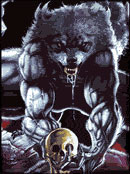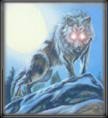|

Stories
The Beast of Le Gevaduan
In 1764 an area of France was experiencing a rash of murders among sheep herders who worked
in the desolate mountain pastures. Rumors began to surface about the "loup-garou". Witnesses claimed to have seen
a creature with short red fur and a pig-like snout. The king of France sent soldiers to the area to kill the creature. Once
there, the soldiers encountered and shot the beast. The wounded beast retreated into the heavy brush, and for a few months
the killings stopped. Later that year the killings started again. A hunting party was formed to try to rid the area of this
terror. One of the hunters, Jean Chastel, loaded his gun with silver bullets. He caught sight of the beast and shot it twice.
The party then took the dead beast down to the town for display. It was buried in the town and Jean's gun is still on display
in a local church.
Amazon-Weres
In the jungles of Peru, natives use a potion similar to the "magic salve" used by the Medieval
werewolves. The salve produces a hallucinogenic effect which puts them in touch with the spirit world. Once there they can
take on the shapes of animals such as Tigers, Panthers, Jaguars and snakes.
In other societies there are more "Weres"
than just wolves.
The Beserkers
In the Folk Tales of the Norseman, there are legends of warriors called "Beserkers". When engaged
in battle , these warriors would go into a frenzy, fearing no one, feeling no pain, having superhuman strength and never surrendering.
Before a battle the warriors would dress with a shirt made of bear or wolf skin (The term Beserker translates to "men
in bearskin coats" and the warriors who donned the wolf skins were known as "ulfheobar", but today both groups
are both described as Beserkers). The feeling was that once dressed with the skins of an animal, the warrior would take on
the characteristics of that animal. A Byzantine emperor described the Beserkers in battle as being possessed by a ferocity
and madness seen only in wild beasts. The term "berserk" was derived from the Beserkers.
The Norththumberland Werewolf
In the Northumberland Country of Pennsylvania, a tale is told of a young sheep herder,
and her lycanthropic admirer. The young girl was a cheerful child, and liked by everyone in the community, especially a solitary
old man who everyone regarded with fear. The old man would always follow the young girl, and also sit and watch her as she
tended to her father's flock of sheep.
Although many wolf attacks were reported even during broad daylight, the
flock that the young girl tended to remained unharmed. This went on for several years, until a farmer spotted a wolf in the
moonlight. He took a shot at it, and the wolf cried out, then retreated into the bushes. When the man went to check if his
shot had killed the wolf, he found the old man dead with a bullet in his chest. The girl continued to tend to her sheep herd
and never once was it attacked by wolves
The Were-Owl of China
In the mid 1700's, babies were dying in what is now Beijing China. Wherever they struggled
for life, an owl was always observed nearby. Hearing of the owl, an archer waited in the room where yet another baby was dying.
Once spotted, he shot the owl which left a trail of blood while escaping. Following the trail the archer discovered a servant
girl who was incapacitated by a wound to her loin. She admitted leaving her room at night to feed on the babies brains. She
was burned alive and the epidemic came to a close.
|
 |
 |
 |










|
 |
 |
 |
|

Stories
The Story of Lycaon
The story of Lycaon, which originated in Greek mythology, has been viewed as one of the first
werewolf stories ever. According to legend, Lycaon was a cruel leader of a cult. Rumors of the atrocities committed by Lycaon
and his cult made their way back to the God Jupiter, who decided to investigate. He found these rumors to be fact, and decided
to reveal his identity to the cult. The members immediately paid homage to Jupiter, however, Lycaon did not believe that he
was a real God and prepared a feast for him consisting of human flesh. If Jupiter truly was a God, he would recognize the
meal and decline to eat it, since cannibalism was a great sin. Jupiter immediately noticed what the feast consisted of. To
avoid Jupiter's wrath, Lycaon fled to the countryside. Once there he found out what Jupiter had in store for him, slowly he
began to transform into a man-wolf. The term "lycanthropy" was derived from Lycaon's name.
A Harz Mountain Werewolf Tale
Count van Breber and his countess Hilda were vacationing in the Harz Mountains in
Germany. One night they stopped over at an inn, and, while talking to the innkeeper, they told him of how they had terrible
difficulty crossing a brook on their way. The innkeeper identified the brook, and then told the couple that they should never
drink from the brook. Realizing that she had taken a drink from the brook, Hilda grew horrified. Soon after she began to
have nightmares, and act peculiarly. Also around that time, a string of child-snatchings began to take place.
One
night, a woman came into the office of the Count, and begged him to follow her, claiming that she had seen the beast who took
her child. The woman was able to run faster than the Count, and chased the beast into a house. From the outside, the Count
heard screams, mixed with animal noises. After he got inside, the Count saw the dead body of the woman, along with the hooded
beast in the corner. He noticed the shape of a woman, but also, signs of hair growing rampantly on her body. The beast went
for the window, causing the Count to shoot. When he found a light, he was able to see clearly that the person he had shot
was his countess.
The Beauty is a Beast
In the mountains of Auvergne, a story was told of a royal female werewolf. In the story, a nobleman
was gazing out of his window and noticed a hunter he knew. He asked him to check back with details of the hunt. While in the
forest, the hunter encountered a wolf, and in the ensuing struggle, he severed one of the wolf's paws. He placed the paw in
his knapsack, and returned to the castle with his prize.
When he opened the knapsack to show the nobleman evidence
of his encounter, they discovered that there was no paw at all. In fact, the knapsack contained a woman's hand wearing a gold
ring. Recognizing the ring as that of his wife's the nobleman decided to question her about her daily activities. When he
went into her room, he found her concealing her arm. Once uncovered, the lack of a hand revealed her true identity.
Upon further questioning she admitted to being the wolf with whom the hunter encountered, and by her confession, she marked
herself for certain execution.
Gilles Garnier
In the sixteenth century town of Dole, a proclamation was publicly read in the town square. It's contents
gave permission for the people to track down and kill the werewolf, that had been terrorizing the village.
While
walking through the forest, a group of peasants heard the screams of a small child accompanied by the howling of a wolf. When
they arrived they saw a wounded child fighting off a monstrous creature whom they later identified as Gilles Garner. When
a ten year old boy disappeared in the vicinity of Garrier's home, he was arrested and confessed to being a werewolf. He was
then burned at the stake.
|
 |
|
|
|

